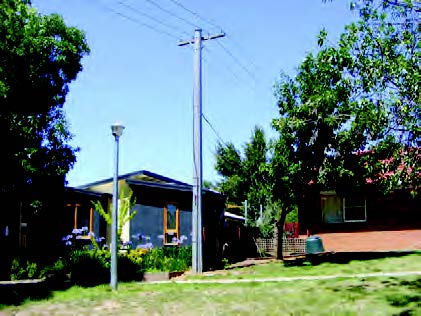ActewAGL is installing composite poles into Canberra backyards from Armor Utility Structures for use in the power grid.

A legacy of Canberra's original planning, ActewAGL has about 28,000 low voltage poles in residential and commercial backyards within the ACT.
As the poles are in backyards, the restricted access does not allow the installation of a standard wooden, concrete or steel single piece pole.
The only multi-piece poles available for installation with a lifting beam are composite and steel. The advantages of composite poles compared with steel poles are lighter weight, non conductive, non corrosive and less expensive.
The poles used in the replacement were a non conductive, lightweight pole which can be installed with light machinery and a lifting beam with a lower overall cost than wooden poles.
Mini excavators and elevated work platforms, scaffolding and ladders are used to maintain and/or replace backyard low voltage poles. Three piece steel poles are used as each section is small enough to be man handled into position and installed onsite by a manual carbon fibre lifting beam. The pole hole and pole base is installed by a mini excavator.
The fibre reinforced composite poles were sources from Canada by the local licencee AUS, who are planning to manufacture the poles locally in the near future.
There are now 86 fibreglass low voltage poles in service in the ACT and another 72 will be installed. The project is expected to be completed in July.
The poles have a polyurethane-based resin which provides structural advantages over traditional polyester or vinyl-ester based resins without diminishing the dielectric strength, resistance to rot and elimination of corrosion concerns and damage from insects and birds that the earlier composites were noted for.
The poles come predrilled for standard applications and utilize concrete pole fittings for special applications. Unused holes are plugged to prevent access by bees, wasps and birds.
According to ActewAGL's overhead asset manager Wayne Cleland, the major challenges were arriving at the correct design configuration to meet ActewAGL requirements and suit the manufacturers standard range of products on offer.
Modifications had to be made to the lifting device to allow for steel and fibreglass pole lifts as the poles have different centres of gravity. Staff were then trained in the installation.
The fibreglass poles are made from two pieces. The first section is installed by the excavating machine prior to an outage. The new fibreglass pole is installed as close to the existing pole as possible. The second stage is installed using a carbon fibre lifting beam specifically designed for installing multi-piece poles in restricted locations.
The lifting beam attaches the first stage of the fibreglass pole with the second stage hauled into position manually using a pulley system attached to the lifting beam.
The lifting beam has been made from carbon fibre and aluminum to reduce the weight as the lifting beam is installed manually by the line staff during the pole replacement outage. The old wooden pole is cut down in stages to enable its removal from site.
Fibreglass poles are consistent with ENA Specifications 009 for pole supply and performance has been trialled.
Further development is proposed for the use of fibreglass poles on ActewAGL's high voltage network.